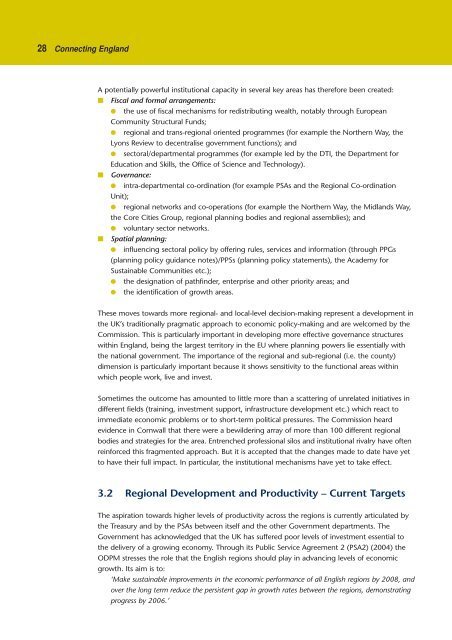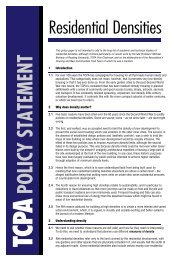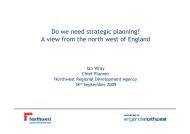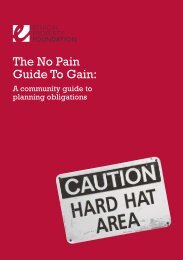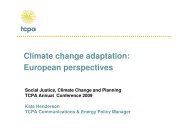Download Connecting England - Town and Country Planning ...
Download Connecting England - Town and Country Planning ...
Download Connecting England - Town and Country Planning ...
Create successful ePaper yourself
Turn your PDF publications into a flip-book with our unique Google optimized e-Paper software.
28 <strong>Connecting</strong> <strong>Engl<strong>and</strong></strong>A potentially powerful institutional capacity in several key areas has therefore been created:■ Fiscal <strong>and</strong> formal arrangements:● the use of fiscal mechanisms for redistributing wealth, notably through EuropeanCommunity Structural Funds;● regional <strong>and</strong> trans-regional oriented programmes (for example the Northern Way, theLyons Review to decentralise government functions); <strong>and</strong>● sectoral/departmental programmes (for example led by the DTI, the Department forEducation <strong>and</strong> Skills, the Office of Science <strong>and</strong> Technology).■ Governance:● intra-departmental co-ordination (for example PSAs <strong>and</strong> the Regional Co-ordinationUnit);● regional networks <strong>and</strong> co-operations (for example the Northern Way, the Midl<strong>and</strong>s Way,the Core Cities Group, regional planning bodies <strong>and</strong> regional assemblies); <strong>and</strong>● voluntary sector networks.■ Spatial planning:● influencing sectoral policy by offering rules, services <strong>and</strong> information (through PPGs(planning policy guidance notes)/PPSs (planning policy statements), the Academy forSustainable Communities etc.);● the designation of pathfinder, enterprise <strong>and</strong> other priority areas; <strong>and</strong>● the identification of growth areas.These moves towards more regional- <strong>and</strong> local-level decision-making represent a development inthe UK’s traditionally pragmatic approach to economic policy-making <strong>and</strong> are welcomed by theCommission. This is particularly important in developing more effective governance structureswithin <strong>Engl<strong>and</strong></strong>, being the largest territory in the EU where planning powers lie essentially withthe national government. The importance of the regional <strong>and</strong> sub-regional (i.e. the county)dimension is particularly important because it shows sensitivity to the functional areas withinwhich people work, live <strong>and</strong> invest.Sometimes the outcome has amounted to little more than a scattering of unrelated initiatives indifferent fields (training, investment support, infrastructure development etc.) which react toimmediate economic problems or to short-term political pressures. The Commission heardevidence in Cornwall that there were a bewildering array of more than 100 different regionalbodies <strong>and</strong> strategies for the area. Entrenched professional silos <strong>and</strong> institutional rivalry have oftenreinforced this fragmented approach. But it is accepted that the changes made to date have yetto have their full impact. In particular, the institutional mechanisms have yet to take effect.3.2 Regional Development <strong>and</strong> Productivity – Current TargetsThe aspiration towards higher levels of productivity across the regions is currently articulated bythe Treasury <strong>and</strong> by the PSAs between itself <strong>and</strong> the other Government departments. TheGovernment has acknowledged that the UK has suffered poor levels of investment essential tothe delivery of a growing economy. Through its Public Service Agreement 2 (PSA2) (2004) theODPM stresses the role that the English regions should play in advancing levels of economicgrowth. Its aim is to:‘Make sustainable improvements in the economic performance of all English regions by 2008, <strong>and</strong>over the long term reduce the persistent gap in growth rates between the regions, demonstratingprogress by 2006.’


